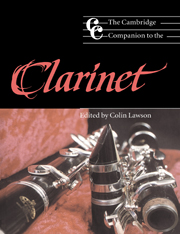Book contents
- Frontmatter
- 1 Single reeds before 1750
- 2 The development of the clarinet
- 3 The clarinet family
- 4 The development of the clarinet repertoire
- 5 Players and composers
- 6 The mechanics of playing the clarinet
- 7 Teaching the clarinet
- 8 Playing historical clarinets
- 9 The professional clarinettist
- 10 The contemporary clarinet
- 11 The clarinet in jazz
- 12 The clarinet on record
- Notes
- Appendices
- Select bibliography
- Index
8 - Playing historical clarinets
Published online by Cambridge University Press: 28 September 2011
- Frontmatter
- 1 Single reeds before 1750
- 2 The development of the clarinet
- 3 The clarinet family
- 4 The development of the clarinet repertoire
- 5 Players and composers
- 6 The mechanics of playing the clarinet
- 7 Teaching the clarinet
- 8 Playing historical clarinets
- 9 The professional clarinettist
- 10 The contemporary clarinet
- 11 The clarinet in jazz
- 12 The clarinet on record
- Notes
- Appendices
- Select bibliography
- Index
Summary
Background
Many different types of early clarinet have long been familiar from photographs in books and journals, but a number of these are now actually being used in historical performances world-wide, giving a quite new perspective to the art of clarinet playing. The expectations of the great composers in terms of sound and musical style (‘performance practice’) has become a lively subject for discussion, widely reflected within such periodicals as the Galpin Society Journal and Early Music. There has always been much detail which a composer did not trouble to write into his scores; he simply knew that certain conventions would be observed. Some of these conventions are no longer current, whereas others have undergone significant changes of meaning. Using a clarinet for which a particular repertoire was originally intended may well make the music sound more expressive and can make more sense of what the composer actually wrote. Is the kind of performance anticipated by Mozart in his own day valid for later generations of players? We can never really answer this question, if only because life has changed so much during the last couple of centuries. The importance of the microphone in our musical lives, coupled with the various implications of air travel, are two factors which have brought about such changes that we do not have the option to turn back the clock. Even if we could hear Anton Stadler's premiere of Mozart's Clarinet Concerto from 1791, we should not necessarily want to adopt all of its features, since to some degree twentieth-century taste would almost certainly continue to influence our interpretation.
- Type
- Chapter
- Information
- The Cambridge Companion to the Clarinet , pp. 134 - 149Publisher: Cambridge University PressPrint publication year: 1995
- 5
- Cited by



